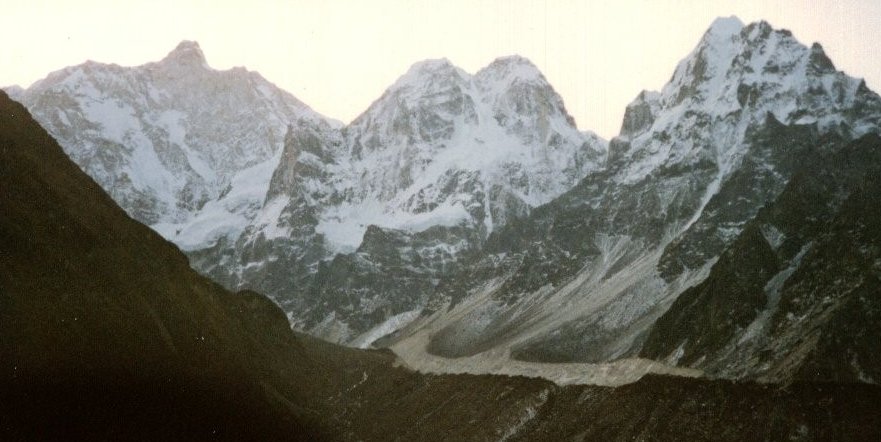

Trek to Mount Kangchenjunga
The multi-summited Kangchenjunga, the world's third highest mountain, lies in the extreme north-eastern corner of Nepal requiring some 30 days for the classic trek that visits both the Yalung Glacier on the southern side and the Kangchenjunga Glacier on the northern. In the spring ( pre-monsoon season ) when the hillsides are ablaze with flowering azaleas and rhododendron, it is reputed to be the most beautiful walk in the world.
 from Lhonak |
|
Only groups self-sufficient in food and fuel are allocated permits for the Kangchenjunga Region and provide welcome employment for porters from the local Rai and Limbu peoples ( two of the Nepalese hill-tribes, who together with the Gurungs and lowland Chetris, provide the backbone of the Gurkha regiment ). Most come from subsistence-level, family farms and rely on trekking for hard cash for the purchase of clothing, tools and utensils. At the start of my "solo" trek I had a crew of 13:- Prem Rai, sirdar, Lalu Limbu, cook, Nima Sherpa, kitchenboy and ten porters - nine of them carrying food.
On the southern approach from the picturesque town of Ilam, in the tea-growing region of Nepal, the vegetation changes with increasing altitude from lush, sub-tropical rice-paddies and banana palms, through alpine forests of fir and pine, to the arctic tundra of the yak pastures at Ramze nestling beneath the moraines of the Yalung Glacier.
Both Ramze and its counterpart Lhonak on the northern side are magnificent campsites amidst spectacular himalayan peaks overlooked by the tremendous rock and ice massif of Kangchenjunga.
 Kangchenjunga from Oktang
|
|
"This is a special place " declared Prem at Oktang, the viewpoint at the end of the trekking route, as he constructed a stone cairn in homage to the mountain.
 |
Lhonak on the northern side is only reached after an arduous crossing of the Sinian La high pass ( or the more difficult Lapsang La ) and heading up the remote Ghunsa Khola Valley for a further two days beyond the compact Sherpa village of Ghunsa with its timber-built houses, multi-coloured mani-stones and long, white, vertical prayer-flags.
Regrettably a circuit of Kangchenjunga is not possible as the necessary crossing of the international border with Sikkim is forbidden. However it is a different, and sometimes dangerous, return route from Ghunsa down the Tamur River Valley and along the broad crest of the Milke Dande to the roadhead at Basantapur.
( From "Heavenly Pursuits", Weekend Extra, Glasgow Herald, 17th August 1996 )